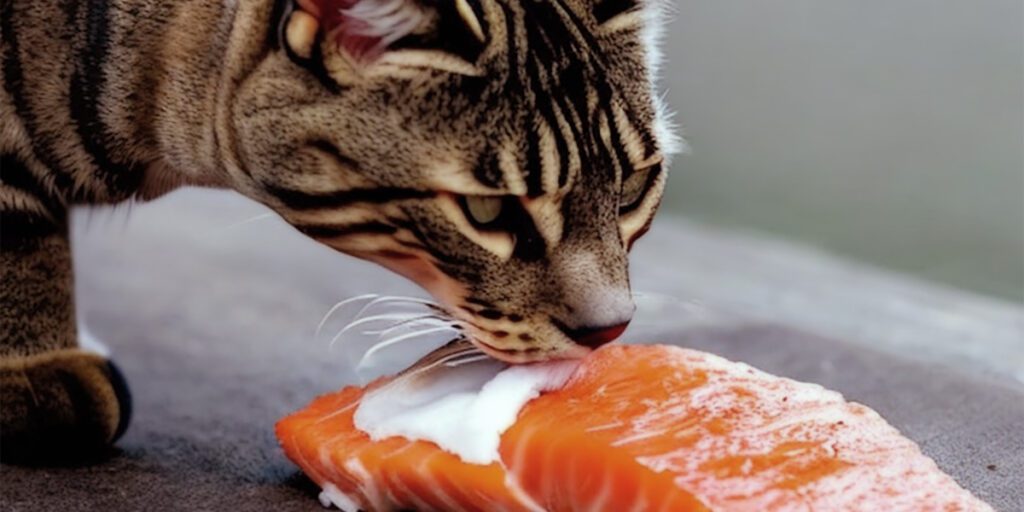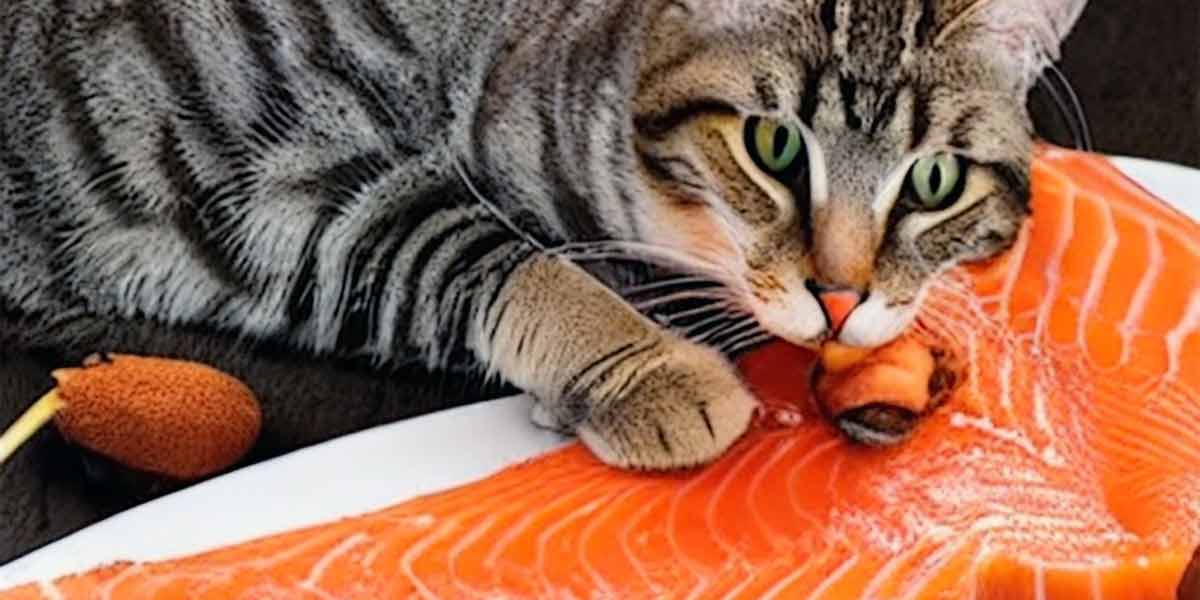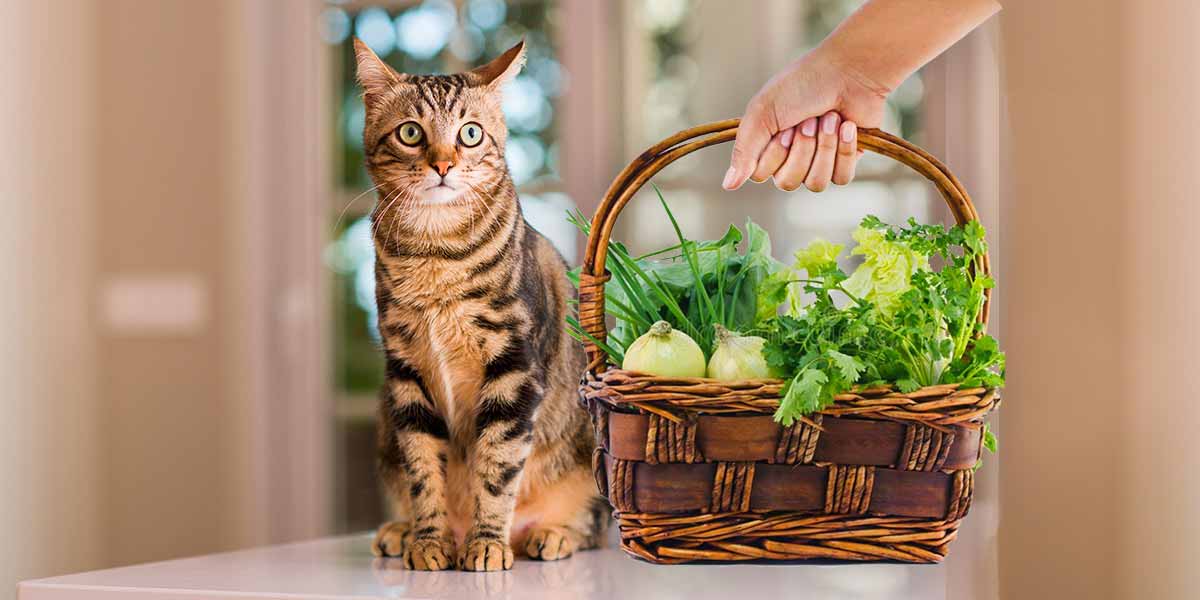As pet owners, we want to provide our feline friends with the best possible nutrition to keep them healthy and happy. One food that has gained popularity for cats is salmon, a nutritious and tasty fish many enjoy. Our site’s readers ask us: Can I feed my cat salmon?
The answer is yes but with some caveats. In this blog post, we will explore the benefits and risks of feeding salmon to cats, as well as provide tips on how to do it safely and in moderation. Whether you are a seasoned cat owner or a new one, this post will provide you with valuable information on whether or not to add salmon to your cat’s diet.
As an affiliate, we earn from qualifying purchases. We get commissions for purchases made through links in this website’s posts from Amazon and other third parties.
It is essential for our readers to understand the significance of feeding their cats a well-balanced diet that meets their nutritional needs. While some human foods like salmon can be a great source of nutrition for cats, it is important to approach feeding them with caution.
Not only can feeding them the wrong diet lead to problems like obesity and gastrointestinal distress, but it can also cause more severe health concerns. That’s why talking to your vet before making any changes to your cat’s diet is paramount, and taking extra precautions such as cooking the salmon and limiting portions can go a long way in keeping your feline friend healthy and happy.
By understanding the benefits and risks of feeding salmon to your cat, you can make an informed decision and provide the best possible care for your furry companion.

Can I feed my cat salmon? Your vet can advise you on whether salmon is a good food choice!
Adding salmon to your feline friend’s diet can be a tricky affair. While it is a rich source of protein, vitamins, and healthy fats, it can also cause adverse reactions in some cats. That’s why it’s important to check with your vet before introducing salmon to your cat’s diet. Here are a few tips and tricks to help you navigate this decision:
Understand the nutritional needs of your cat
Cats need a balanced diet that includes proteins, fats, vitamins, and minerals. Before introducing a new food item, it’s essential to understand whether it’s suitable for your feline friend’s nutritional requirements.
Discuss your cat’s health with your vet
If your cat has underlying health conditions, such as kidney disease or food allergies, certain foods can aggravate the problem. Therefore, it’s essential to have an informed discussion with your veterinarian about your cat’s health before introducing any new food to their diet.
Assess your cat’s reaction to salmon
Even if your vet approves of salmon as a food choice for your cat, it’s best to introduce it in small quantities at first. Watch your cat’s reaction for the next 24-48 hours. Some cats may show symptoms of food intolerance or allergies, such as vomiting, diarrhea, or skin irritation.
Buy high-quality salmon
Not all salmon are created equal. Opt for high-quality, human-grade salmon that is free from additives or preservatives. Some cat food brands also offer salmon-based products that are formulated to meet the nutritional needs of felines.
In conclusion, salmon can be a nutritious addition to a cat’s diet, but it’s essential to consult with your vet first. With careful consideration and monitoring, your cat may enjoy the taste and health benefits of this delicious fish.

While salmon is high in omega-3 fatty acids, it is also high in fat.
Salmon is delicious and healthy food for humans, and it is not uncommon for pet owners to want to share some with their furry companions. However, when it comes to feeding your cat salmon, it is important to exercise caution and moderation.
While salmon is high in omega-3 fatty acids, which have many benefits for your cat’s health, it is also high in fat. Therefore, it is essential to limit the amount of salmon you give to your cat to avoid health risks such as obesity or pancreatitis.
Here are some key tips and useful information to keep in mind when it comes to feeding salmon to your cat:
- Only give your cat small portions of salmon. A little goes a long way, as far as their nutritional needs are concerned.
- Cook the salmon well and make sure there are no bones present. Bones can be a choking hazard to your cat and can cause digestive problems.
- Avoid feeding your cat raw salmon, as it can contain harmful bacteria and parasites that can make your cat sick.
- If your cat has a history of pancreatitis or other digestive issues, it is best to avoid feeding them salmon altogether.
- If you are uncertain about feeding salmon to your cat, speak to your veterinarian. They will be able to advise you on how to safely include this food in your cat’s diet.
In conclusion, while salmon can be a healthy and delicious treat for your cat, it is important to exercise caution and moderation. By limiting the amount of salmon you give to your cat and taking proper precautions, you can ensure that your furry companion stays healthy and happy.
Cooked salmon is better! Raw salmon can be contaminated with parasites, bacteria, or other harmful substances.
Cooking salmon for your cat can be a great way to provide them with a healthy and balanced diet. It is a lean source of protein, and it is full of essential fatty acids, vitamins, and minerals.
Cooked salmon is better for cats as it is easier for them to digest. Raw fish can be contaminated with parasites, bacteria, or other harmful substances that can easily harm your cat.
Watch the next video: How to cook salmon for your cat
Here are some key factors you should consider when cooking salmon for your cat:
- Use only fresh or frozen salmon for your cat. It is important to ensure that the fish is not spoiled or contaminated.
- Always cook the salmon thoroughly, as undercooked salmon can contain dangerous bacteria.
- Only use boneless and skinless salmon for your cat. Bones can splinter and cause a choking hazard.
- Avoid adding any spices, sauces, or seasonings to the fish. Cats have sensitive digestive systems and these ingredients can cause digestive issues.
- Dispose of any cooked fish that your cat doesn’t eat within a few hours.
- If you are feeding your cat raw salmon, make sure it is from a reputable source, and it is frozen for at least 15 days to kill off any parasites.
By following these steps, you can ensure that your cat is getting all the nutrition they need from their diet and that they are staying safe and healthy.
Conclusion
In conclusion, the decision to feed your cat salmon should not be taken lightly. It is important to consult your veterinarian to determine if salmon is a good fit for your cat’s diet and health. If you decide to feed your cat salmon, limit the amount given and make sure to cook it first.
This will reduce the risk of your cat ingesting harmful parasites, bacteria, or other substances. With the right precautions, salmon can be a part of a healthy diet for cats. For readers who want to ensure their cat’s diet is optimal, Salmon can be a delicious and nutritious addition.






